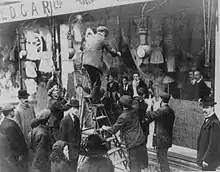Mary Jane Clarke
Mary Jane Clarke (born Mary Jane Goulden; 1862–1910), was a British suffragette. She died after being force fed whilst in prison on Christmas Day 1910 - the suffragette's "first woman martyr". She was the younger sister of suffragette Emmeline Pankhurst and she had been arrested in 23 November 1910.
Mary Jane Clarke | |
|---|---|
 | |
| Born | Mary Jane Goulden 1862 Salford, Manchester, England |
| Died | 1910 (aged 47–48) London, England |
| Nationality | British |
| Occupation | Suffragette |
Biography
Clarke was born in Salford and was one of ten children; her older sister Emmeline Pankhurst being one of them. Her father was the managing director of a cotton-printing works.[1] She was educated at the École Normale Supérieure, Paris along with her sister. She was co-founder with Emmeline of the Emerson & Co. shop in Hampstead Row.[2] At the shop, her artistic skills added decoration of the shops’s stock of art-enameled fancy goods and was described in the 1891 census as a "decorative artist". After the Pankursts moved to Manchester in 1893, she helped to reliance Emerson's there in 1898.[1] In December 1895, she married John Clarke. By 1904 she left him, and lived with her niece Sylvia Pankhurst.[2]
In the early years of the Women’s Social and Political Union, Clarke acted as Emmeline Pankhurst's deputy as registrar in Manchester. By February 1906, she was fully involved in the WSPU and in 1907 was appointed a WSPU organiser. In 1909, she led a group, including Irene Dallas, to Downing Street, and was arrested and sentenced to one month in prison.[2]
Clarke was given a Hunger Strike Medal 'for Valour'.
After being released, Clarke began speaking for the WSPU in Yorkshire in 1909 and by the summer was the organizer supported by Minnie Baldock who was financially supported by Minnie Turner to help Clarke [3] on the south coast in Brighton.[1] Clarke was calm and self-controlled when heckled,[4] running the election campaign for the January 1910 United Kingdom general election.[2]

Clarke was admired by fellow suffragette, Joan Dugdale for “superhuman strength of spirit” as well as “sweet sympathy and gentleness”, after getting hurt in an angry crowd throwing rotten apples at them at Bournemouth.[4]
Clarke also took part in the protests when many women were assaulted by the police, known as Black Friday (1910), on 18 November 1910, but she was only arrested a few days later for window smashing, on 23 November 1910, and imprisoned for a month in HM Prison Holloway where she was force-fed.[5]
Clarke was released on 23 December 1910, and spoke at a suffragette event, travelled to Brighton for another meeting [4]and returned to London.[6] But she died on 25 December 1910, at her brother's home in Winchmore Hill, London.[2] She was described in her obituary by Emmeline Pethick-Lawrence as "the first woman martyr who has gone to death for this cause".[1]
.jpg.webp)
In January 1911 suffragette leader Annie Kenney planted a memorial tree for her in garden of the Blathwayts Eagle House in Somerset, known as the Suffragette's Rest; it was a cedrus deodara pendula.[7]
In popular culture
Mary Jane Clarke appears in the 2018 German docudrama We are half the World (Die Hälfte der Welt gehört uns) about the women's suffrage movement in Germany, France and the United Kingdom, played by Alexandra Schalaudek.[8]
Legacy and memorial
A campaign began in 2018[7] to have a statue of Mary Jane Clarke in the Pavilion Gardens Brighton, a design by sculptor, Denise Dutton was approved in 2020 by the Mayor of Brighton & Hove.[4] It has all party support and charitable purposes for education and human rights awareness, as 'an image of female courage and political leadership, encouraging women and girls to participate in civic life and fostering a better understanding of women’s history.'[7]
The design maquette includes references to Black Friday in Votes for Women newspaper, examples of force-feeding implements, the Hunger Strike Medal and words from Emmeline Pankhurst “She is the first to die. How many must follow…” and also will have 'a lamp at her feet which she has placed there for others to pick up'.[4] The Mary Clarke Statue Appeal is fundraising to complete the project, and its chair, Jean Calder said
“Nationally, women who have achieved a great deal are not commemorated. Mary was this extraordinary woman who made this huge sacrifice and yet she’s been completely forgotten. I can’t believe this would have happened to a man.”[4]
References
- Crawford, Elizabeth (2 September 2003). The Women's Suffrage Movement: A Reference Guide 1866-1928. Routledge. ISBN 1135434026.
- Crawford, Elizabeth (2013). Women's Suffrage Movement. Taylor & Francis. pp. 38, 114–115. ISBN 978-1135434021.
- Diane, Atkinson (2018). Rise up, women! : the remarkable lives of the suffragettes. London: Bloomsbury. p. 213. ISBN 9781408844045. OCLC 1016848621.
- Lock, Rose (20 December 2020). "Appeal to boost funds for Brighton statue of suffragette Mary Clarke". The Argus. Retrieved 29 January 2021.
- Simkin, John. "Mary Jane Clarke". Spartacus Educational. Retrieved 12 August 2019.
- "Suffragette's Death". The Advertiser. 30 December 1910.
- "Mary Clarke Statue Appeal". Mary Clarke Statue Appeal. Retrieved 29 January 2021.
- "We are half the World" (Press release). gebrueder geetz filmproduktion. 2017. Retrieved 9 November 2019.
External links
- "The Suffragettes, Black Friday and two types of window smashing". Counterfire. Retrieved 5 June 2013.
- "Votes for Women". 6 January 1911.
- Elizabeth Crawford (4 June 2013). "Why is Emily Wilding Davison remembered as the first suffragette martyr?". Oxford University Press. Retrieved 5 June 2013.
- Mary Clarke Statue https://maryclarkestatue.com/history/ Retrieved 29 January 2021.